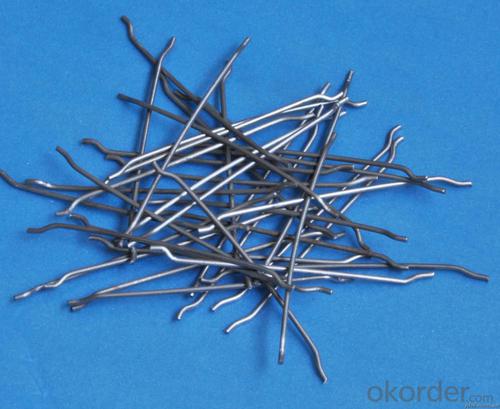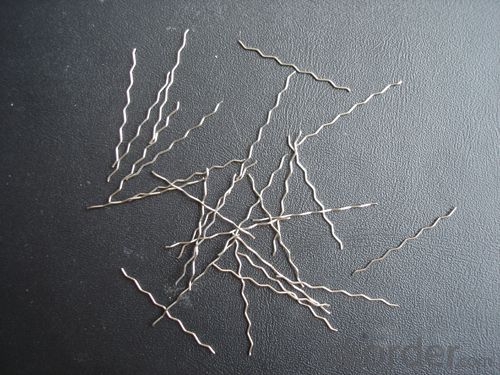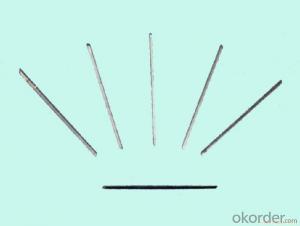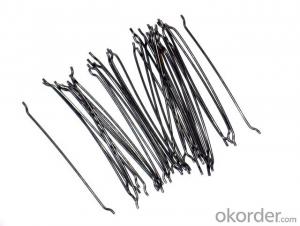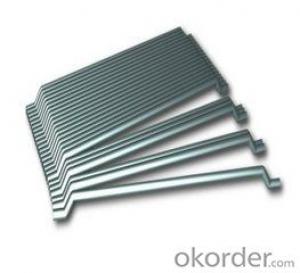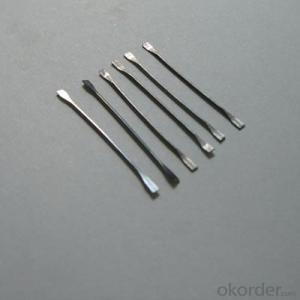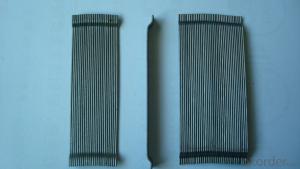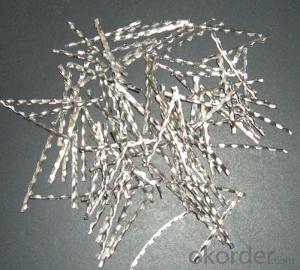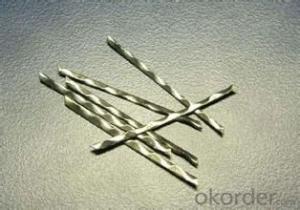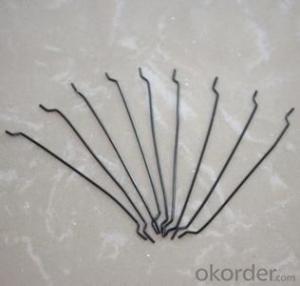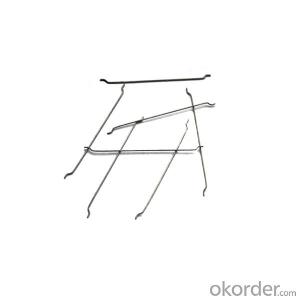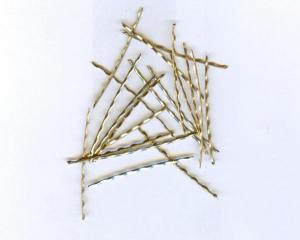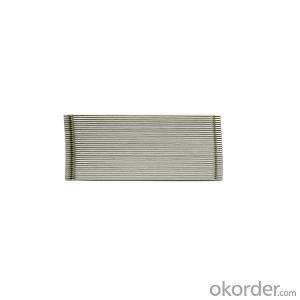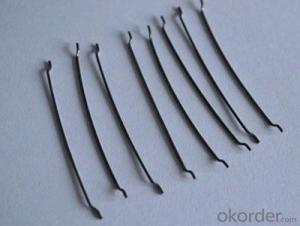Melt Extract Stainless Steel Fiber Wavy for Construction and Concrete from CNBM International
- Loading Port:
- Tianjin
- Payment Terms:
- TT OR LC
- Min Order Qty:
- 1000 kg
- Supply Capability:
- 250000 kg/month
OKorder Service Pledge
OKorder Financial Service
You Might Also Like
Quick Details
material: steel wire
shape: corrugated round fiber
appearance: clean and bright
usage: construction and concrete
Place of Origin: Shandong, China (Mainland)
Model Number: steel fiber
Product features
steel iber for concrete reinforcement ,it`s widely used in buildings ,bridges ,thin roof engineering ,highway etc
cncrete steel iber is specificially designed to enhance concrete in its hardened state ,the uniform distribution of steel fibers throughout the concrete greatly improves concrete bonding and tensile strength ,additionally it provides exceptional load stability and durability ,as reliable and efficient concrete reinforcement material .
it is widely used in buildings ,bridges ,thin roof engineering ,highway etc.
Specifications
Length :20-60mm
Diameter :0.5-1.2
Tensile strength:600Mpa-900Mpa
Appearance :clear and bright steel wire
Style :corrugated round fiber
Picture
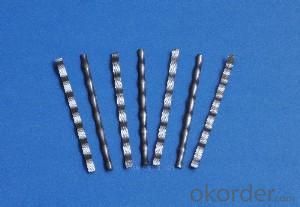
cncrete steel iber is specificially designed to enhance concrete in its hardened state ,the uniform distribution of steel fibers throughout the concrete greatly improves concrete bonding and tensile strength ,additionally it provides exceptional load stability and durability ,as reliable and efficient concrete reinforcement material .
it is widely used in buildings ,bridges ,thin roof engineering ,highway etc.
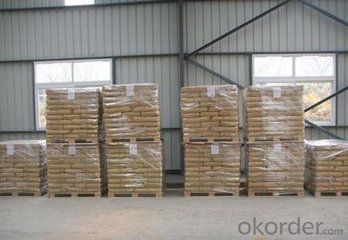
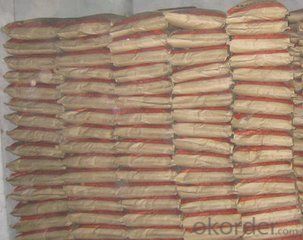
FAQ
we can produce any type steel fiber and of course we can make production according to your requirement
we have specilize in this field for almost 10 years ,with good quality and competitive price
- Q: C50 steel fiber concrete, the minimum price, who will tell
- This has to know the amount of steel fiber and kind of Caixing, different steel fiber price difference is quite big, mixing quantity is different, the cost difference is also very big.
- Q: What is the effect of melt extract stainless steel fiber on the permeability of asphalt mixtures?
- By incorporating melt extract stainless steel fiber into asphalt mixtures, a notable reduction in permeability can be achieved. When stainless steel fibers are introduced into the asphalt mixture, they establish a three-dimensional network within the asphalt matrix. This network serves to enhance the cohesion and strength of the asphalt mixture. The stainless steel fibers function as reinforcement, forming a barrier that limits the movement of water or other fluids through the asphalt mixture. Consequently, the permeability of the mixture is diminished, rendering it more resistant to water damage and enhancing its overall durability. Furthermore, the inclusion of stainless steel fibers aids in preventing the formation of cracks and minimizing the propagation of existing cracks within the asphalt mixture. This further bolsters the performance and lifespan of the asphalt pavement. In summary, the introduction of melt extract stainless steel fiber into asphalt mixtures yields a positive impact on permeability, reducing it and elevating the overall durability and performance of the asphalt pavement.
- Q: Does melt extract stainless steel fiber improve the abrasion resistance of concrete?
- Indeed, the inclusion of melt extract stainless steel fiber has the potential to heighten the abrasion resistance of concrete. Renowned for their robustness, longevity, and corrosion resistance, stainless steel fibers bolster the mechanical attributes of concrete upon integration. By serving as reinforcement within the concrete matrix, these fibers amplify the overall tenacity of the material and impede the propagation of cracks. Consequently, the end product is a concrete that exhibits greater resilience against wear and abrasion, rendering it suitable for deployment in industrial flooring, pavements, and other heavily traversed locales.
- Q: Can melt extract stainless steel fiber be used in earthquake-resistant concrete structures?
- Certainly, earthquake-resistant concrete structures can utilize melt extract stainless steel fiber. Renowned for their exceptional ductility and high tensile strength, stainless steel fibers are an ideal choice for bolstering the toughness and durability of concrete. The inclusion of these fibers in concrete enhances its ability to withstand cracking, shrinkage, and spalling during seismic events. The utilization of stainless steel fibers in earthquake-resistant concrete structures plays a crucial role in mitigating the adverse effects of earthquakes. Acting as reinforcement, these fibers augment the concrete's strength and hinder the propagation of cracks. This reinforcement fortifies the overall structural integrity of the concrete, rendering it more resistant to the dynamic forces unleashed by earthquakes. Furthermore, melt extract stainless steel fibers possess a high melting point, corrosion resistance, and exceptional thermal stability. These attributes render them suitable for long-term implementation in hostile environments, such as earthquake-prone regions. These fibers remain intact over time, ensuring the concrete structure's long-lasting durability and efficacy. Additionally, melt extract stainless steel fibers have undergone rigorous testing and have been proven to enhance the seismic performance of concrete structures. They conform to various international standards, such as ASTM and ACI, guaranteeing their quality and reliability. These fibers have successfully been employed in a diverse array of earthquake-resistant applications, including bridges, tunnels, high-rise buildings, and industrial structures. In conclusion, melt extract stainless steel fiber can indeed be employed in earthquake-resistant concrete structures. Its exceptional tensile strength, ductility, and resistance to cracking make it an outstanding reinforcement material for fortifying the durability and seismic performance of concrete. By incorporating stainless steel fibers into concrete, engineers can effectively bolster the resistance of structures to seismic forces, ensuring the safety and longevity of infrastructure in earthquake-prone regions.
- Q: Can melt extract stainless steel fiber improve the bond strength of concrete to masonry units?
- Yes, melt extract stainless steel fiber can improve the bond strength of concrete to masonry units. Stainless steel fibers are commonly used as reinforcement in concrete to enhance its mechanical properties, including bond strength. The melt extract stainless steel fibers are made through a process where molten stainless steel is rapidly cooled and solidified, resulting in fibers with a high tensile strength. When these stainless steel fibers are added to the concrete mix, they create a three-dimensional reinforcement network within the matrix, which improves the bond between the concrete and masonry units. The fibers act as tiny anchors, preventing the separation of the concrete from the masonry surface under stress. This leads to increased bond strength and enhanced durability of the concrete-masonry interface. Additionally, melt extract stainless steel fibers also help to reduce the formation of micro-cracks in concrete, which can further improve the bond strength. These fibers are resistant to corrosion and have high resistance to alkalis, ensuring long-term performance and stability of the concrete-masonry bond. In conclusion, the addition of melt extract stainless steel fibers to concrete can significantly improve the bond strength between concrete and masonry units, resulting in a more robust and durable structure.
- Q: Does melt extract stainless steel fiber enhance the flexural toughness of concrete beams?
- Concrete beams experience an enhancement in flexural toughness when melt extract stainless steel fiber is utilized. The inclusion of these fibers in concrete mixtures leads to a significant improvement in the beams' ability to withstand bending and flexural forces. By incorporating stainless steel fibers, the material's tensile strength and ductility are increased, resulting in a strengthened resistance to cracking and an overall improvement in toughness. This reinforcement ensures that applied loads are evenly distributed, reducing the likelihood of brittle failure and enhancing the structural performance of the concrete beams. Furthermore, the small size and high aspect ratio of melt extract stainless steel fibers enable better dispersion and bonding within the concrete matrix, further heightening their effectiveness in enhancing flexural toughness.
- Q: Can melt extract stainless steel fiber be used in shot blast applications?
- Certainly! Melt extract stainless steel fibers are applicable for shot blast applications. Shot blasting refers to the high-speed propulsion of abrasive materials to cleanse, refine, or fortify surfaces. In order to bolster the durability and efficacy of this process, stainless steel fibers are frequently incorporated. Melt extract stainless steel fibers are specifically crafted to endure the demanding conditions encountered during shot blasting. Their production involves melting stainless steel and promptly cooling it to create fine fibers possessing exceptional tensile strength, as well as resistance to corrosion and heat. Consequently, these properties render them highly suitable for shot blast applications, as they can withstand the abrasive impact and heat generated throughout the operation. Employing melt extract stainless steel fibers in shot blasting can yield various advantages. Firstly, they amplify the cleansing and refining capabilities of the abrasive materials employed, resulting in a more efficient and effective process. Additionally, the inclusion of stainless steel fibers reinforces and strengthens the surface being blasted, thus boosting its durability and lifespan. To conclude, melt extract stainless steel fibers are indeed well-suited for utilization in shot blast applications. Their exceptional tensile strength, resistance to corrosion, and ability to withstand heat make them an optimal choice for enhancing the performance and longevity of shot blasting processes.
- Q: How does the addition of melt extract stainless steel fiber impact the curing time of concrete?
- The addition of melt extract stainless steel fiber can impact the curing time of concrete in several ways. Firstly, the stainless steel fibers act as a reinforcement material, enhancing the overall strength and durability of the concrete. This can lead to quicker curing times as the concrete gains strength faster. Furthermore, the addition of stainless steel fibers can improve the crack resistance of concrete. By providing additional tensile strength, the fibers help to prevent the formation and propagation of cracks, which can significantly affect the curing time. With fewer cracks, the concrete can cure more evenly and efficiently. Additionally, the stainless steel fibers can also enhance the bond between the concrete matrix and the aggregate particles. This improved bond can lead to better cohesion within the concrete mixture, allowing for faster and more uniform curing. However, it is important to note that the impact of melt extract stainless steel fiber on curing time may vary depending on factors such as the dosage and length of the fibers, as well as the specific mix design and environmental conditions. Therefore, it is crucial to consult with experts and conduct thorough testing to determine the optimal dosage and conditions for achieving desired curing times with the addition of stainless steel fibers.
- Q: Can melt extract stainless steel fiber be used in residential driveway pavements?
- Yes, melt extract stainless steel fiber can be used in residential driveway pavements. These fibers provide enhanced strength and durability to the pavement, making it more resistant to cracking and wear. Additionally, the stainless steel material offers excellent corrosion resistance, making it suitable for long-term use in outdoor settings.
- Q: Is melt extract stainless steel fiber suitable for use in airport runway construction?
- Yes, melt extract stainless steel fiber is suitable for use in airport runway construction. Stainless steel fibers offer excellent durability, corrosion resistance, and high tensile strength, making them ideal for heavy-duty applications like airport runways. They can enhance the overall strength and performance of the concrete, improving its resistance to cracking, impact, and fatigue. Additionally, stainless steel fibers are non-magnetic, which is crucial for airport runways as it prevents interference with sensitive navigation systems. Therefore, melt extract stainless steel fiber is a reliable and appropriate choice for airport runway construction.
Send your message to us
Melt Extract Stainless Steel Fiber Wavy for Construction and Concrete from CNBM International
- Loading Port:
- Tianjin
- Payment Terms:
- TT OR LC
- Min Order Qty:
- 1000 kg
- Supply Capability:
- 250000 kg/month
OKorder Service Pledge
OKorder Financial Service
Similar products
Hot products
Hot Searches
Related keywords



